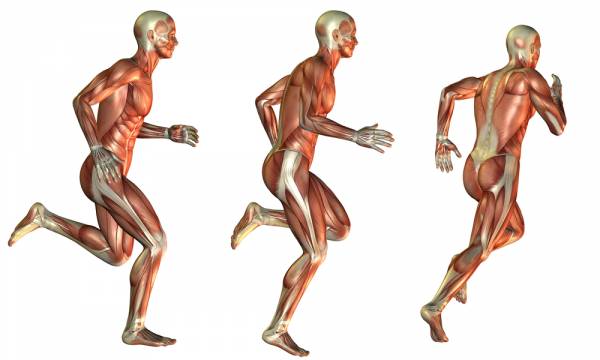If you feel stuck or without gains in your routine, this could be due to overspecialization. Instead, add cross training to achieve overall well being, leapfrog over plateaus, and reduce injury. Introducing new motor skills can decrease repetition-based injury, weakness, or movement challenges.
Is Your Exercise Routine Imbalanced?
Muscles frequently go “offline” and need to be retrained to fulfill their motor function. For example, have you ever had the experience that a muscle was just not firing or moving the way it used to? Are there muscles to which you have a hard time connecting or movements that challenge you? Pinched nerves or lack of training the brain to move a muscle in specific ways can lead to atrophy or feelings of paralysis.
RELATED: How to Recognize, Fix, and Prevent ITB Syndrome
Running on pavement and cardio-focused yoga salutations are two common exercises that concentrate on repetitive movements. They also tend to underutilize the mid-back, posterior thighs, and anterior shins. Specifically, the trapezius, medial hamstrings, and tibialis anterior weaken.
“If you are rusty on a movement, slow down and increase the number of repetitions until you are able to flex any individual muscle without moving a bone. This is muscular intelligence.”
It is easy to understand how pavement running affects the body, but you may be wondering how cardio yoga plays into injury. Several styles of yoga repeat a pattern of movements many times over the course of a class. This sequence, which I call “cardio yoga salutations,” includes the linking of plank, lowering to belly, cobra or upward facing dog, and downward facing dog.
Students love that this activity feels like cardio and produces sweat. But this rapid and repetitive weight-bearing sequence has its drawbacks as it can create shoulder joint degeneration from underutilizing trapezius, medial hamstrings, and tibialis anterior to support the movements.
FREE WORKOUTS FOR BEGINNERS: Start Your Athletic Journey
How to Improve Your Running and Yoga
Here are three motor skills to learn for better gains in running and all yoga. These are precise and simple movements to get these key muscles online and increase proprioception or physiological intelligence.
1. Conscious Flexion of Trapezius
Adduct your shoulder blades toward your spine and depress them toward your pelvis. This voluntary action has additional benefits in signaling pectoralis major, pectoralis minor, and serratus anterior to pause from flexing.
“Pinched nerves or lack of training the brain to move a muscle in specific ways can lead to atrophy or feelings of paralysis.”
The stronger the flexion of mid-back muscles, the greater the stretch the chest receives. This is supportive for the shoulder (glenohumeral) joint to move the arms at an increased rate for pavement running and cardio-yoga salutations.
READ THIS: The Dynamic Duo of Shoulder Impingement
2. Conscious Flexion of Semitendinosis and Semimembranosus
Adduct and extend your thighbones toward each other and back behind your pelvis. This voluntary action signals the quadriceps group, tensor fasciae latae, and iliopsoas to pause from flexion.
RELATED YOGA FLOW: Hip Flexor Fun
The stronger the flexing to extend your thighs back, the greater the stretch the hip flexors receive. This is supportive for the hip joints and pelvis for pulling and pushing the legs efficiently and effectively during running and cardio-yoga salutations.
3. Conscious Flexion of Tibialis Anterior
Flex your foot toward your shin and flex the arch of your foot toward your inner calf. This voluntary action has additional benefits by signaling the calf group – gastrocnemius, tibialis posterior, and soleus to pause from flexing.
“These are precise and simple movements to get these key muscles online and increase proprioception or physiological intelligence.”
The stronger your flexing to lift the arch and foot, the greater the stretch your calf and back of your knee receives. This is supportive for the knee and ankle joints for walking and cardio-yoga salutations.
Diversify Your Movement for Better Results

Whatever sport or activity you do, look for ways to mix it up and diversify movement. This will encourage smaller or underutilized muscles to come online and help carry more weight.
TRY THIS: Basic Tumbling Skills You Should Have
Start with simple and precise movements and feel your way through the entire range of motion. By doing this, you strengthen your mental map of your muscles and their motions. If you are rusty on a movement, slow down and increase the number of repetitions until you are able to flex any individual muscle without moving a bone. This is muscular intelligence. Once you have that, then you are better skilled at turning the muscle on when it becomes lazy.
The old proverb, “If you don’t use it, you lose it” rings true here. Use it. Use them. All 300 (+/-fifteen) muscles of your body. You will be exponentially stronger and smarter for doing so.
Photos courtesy of Shutterstock.






